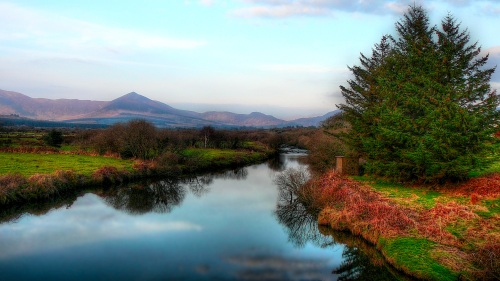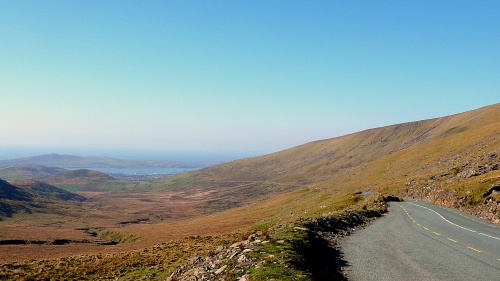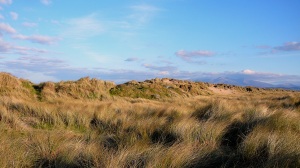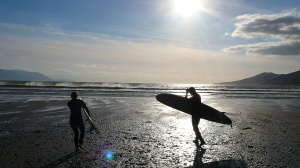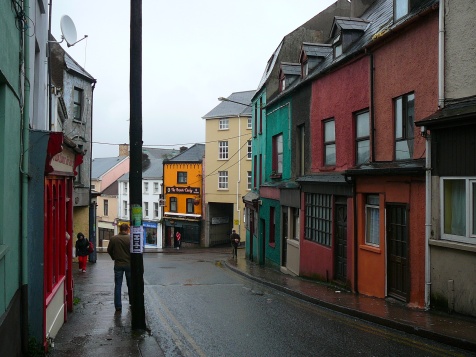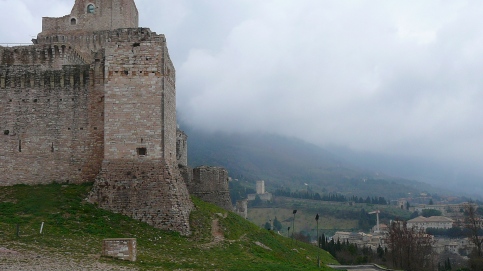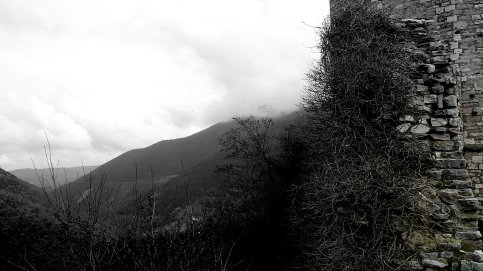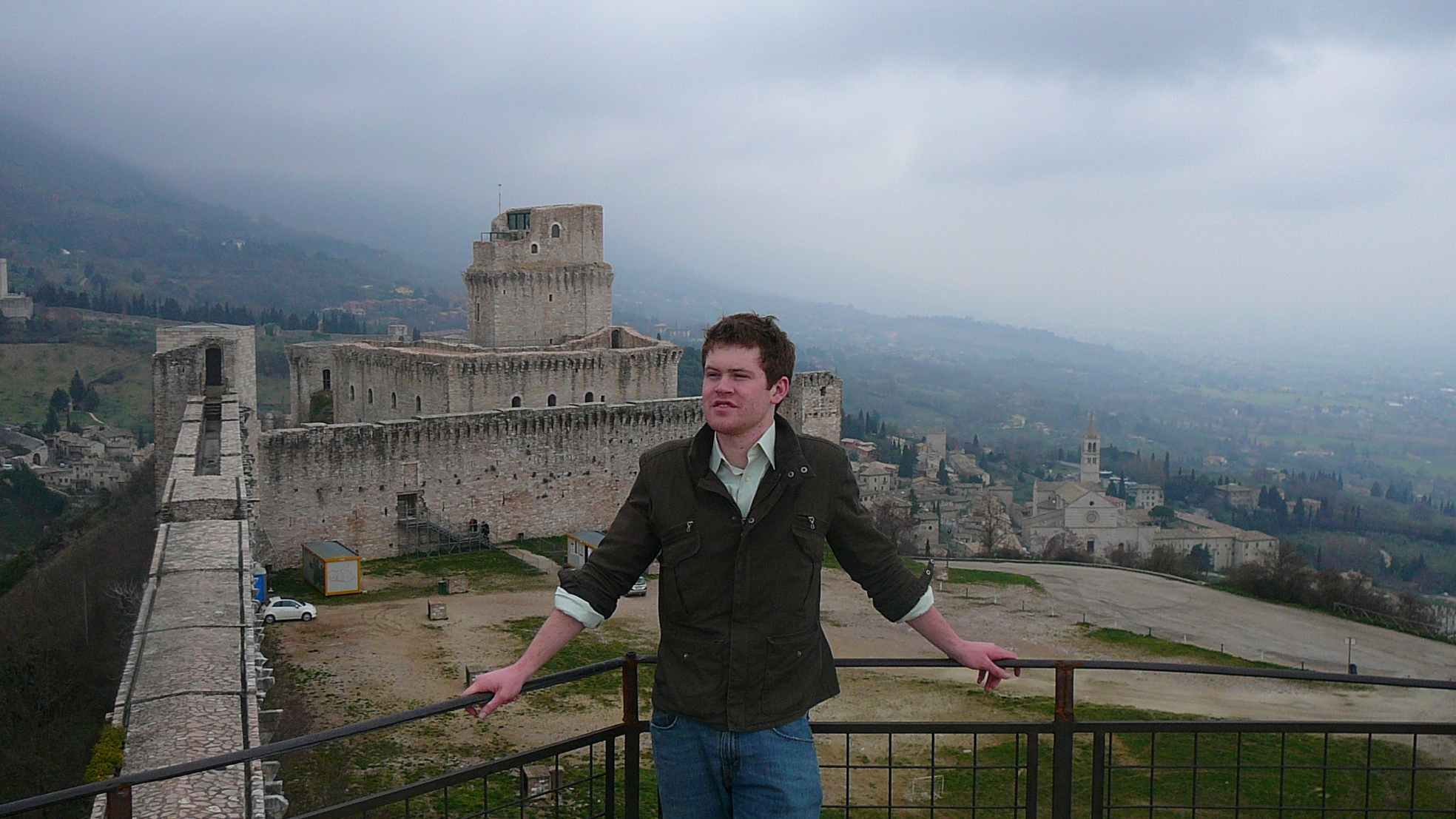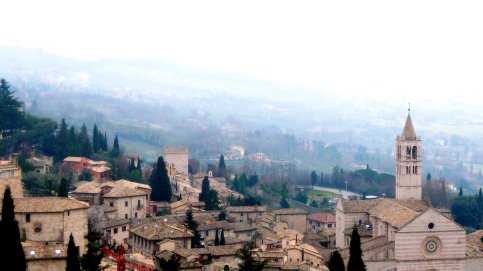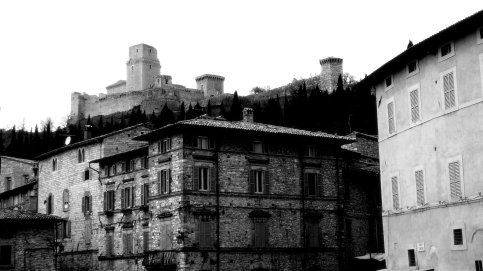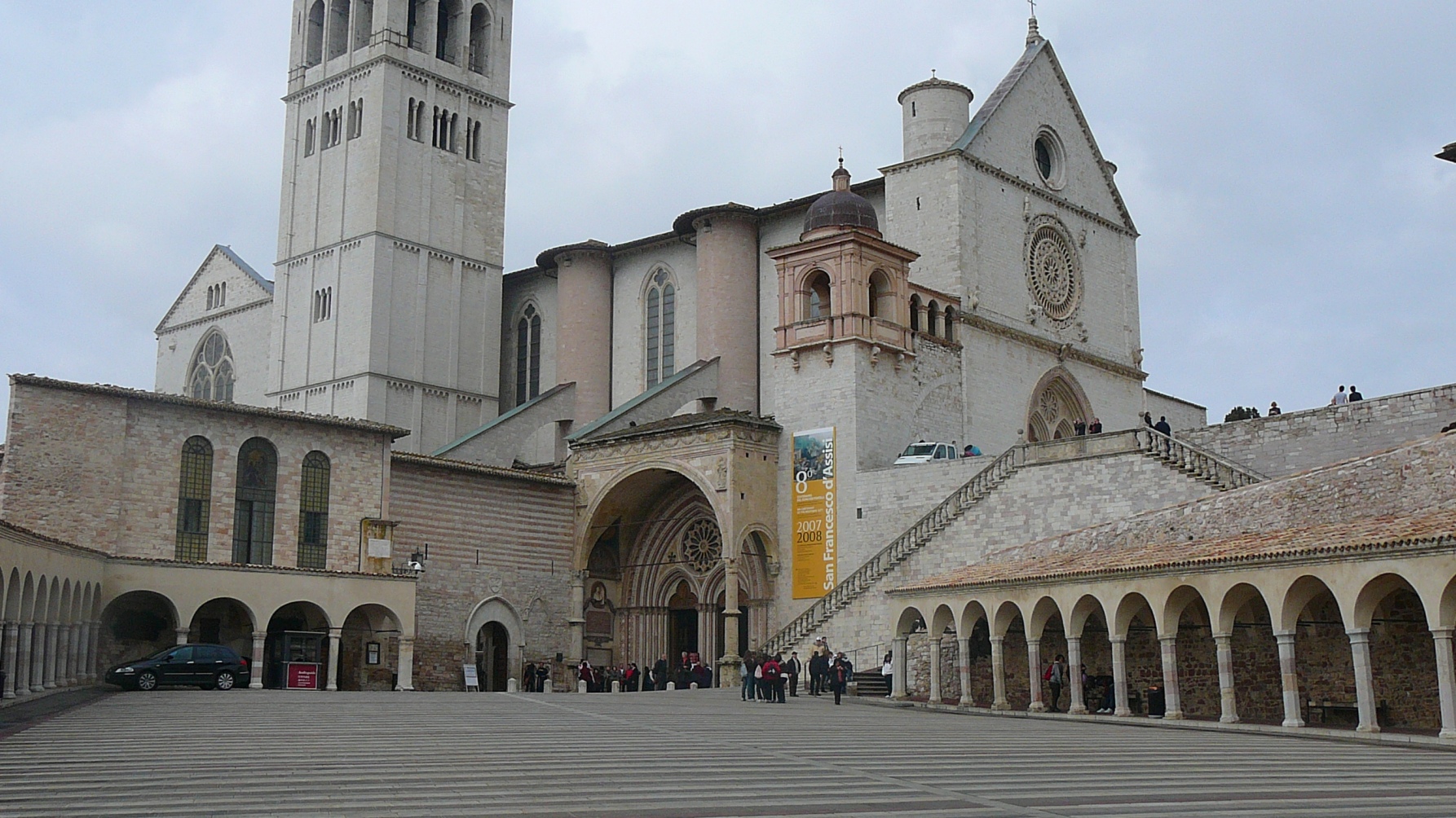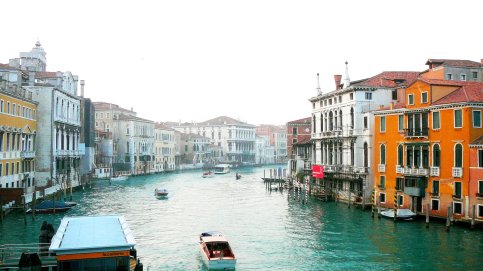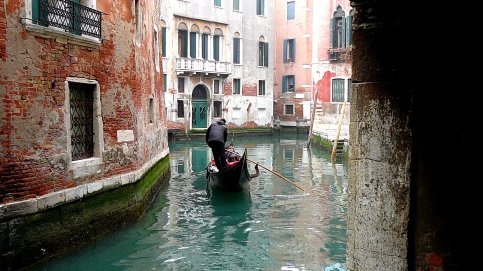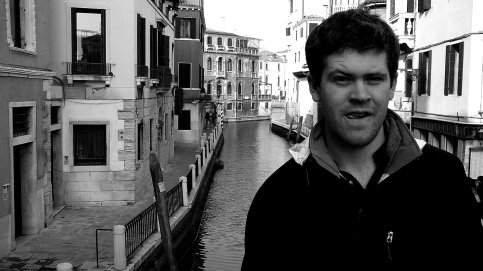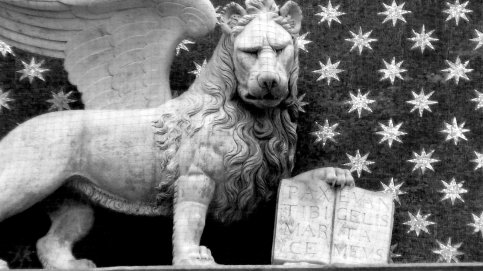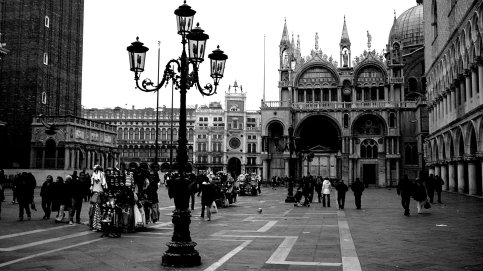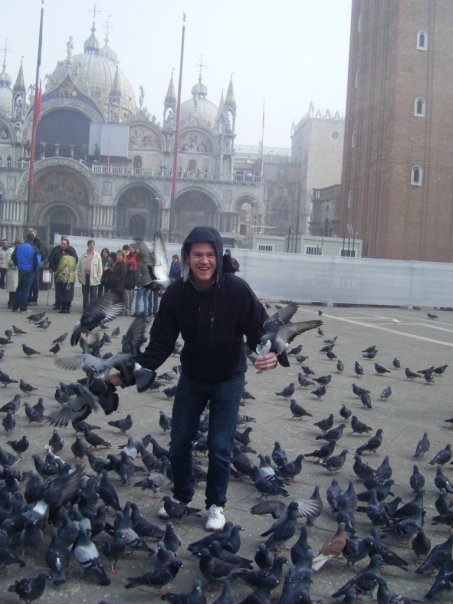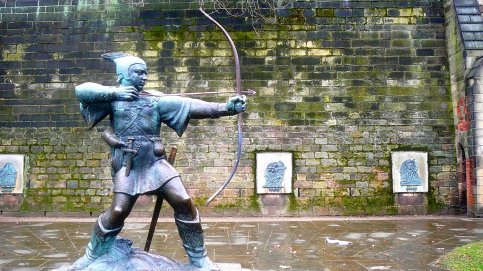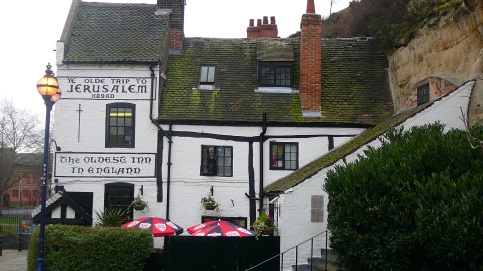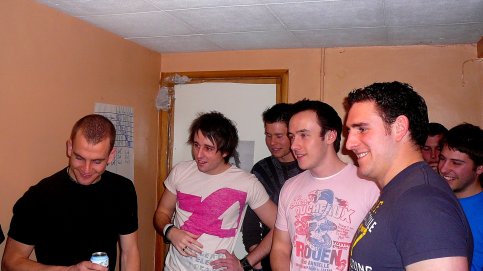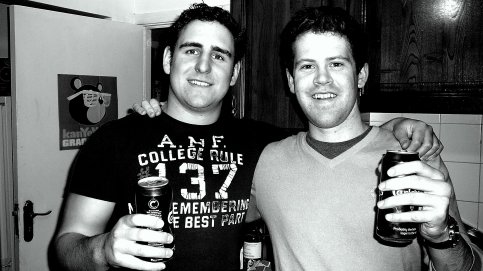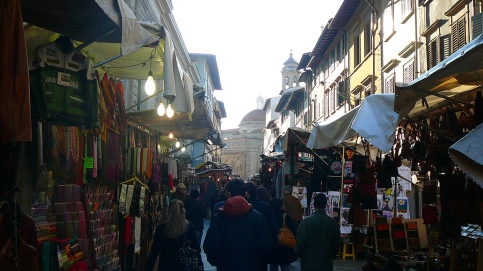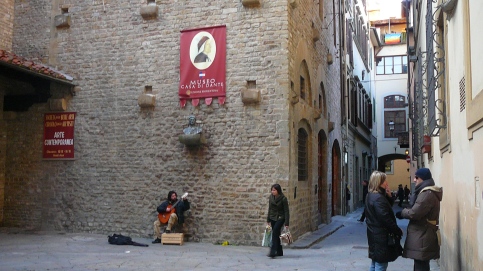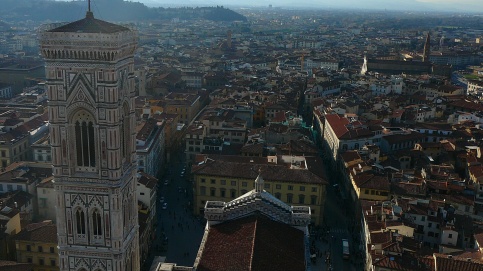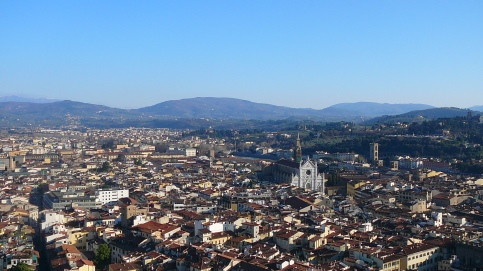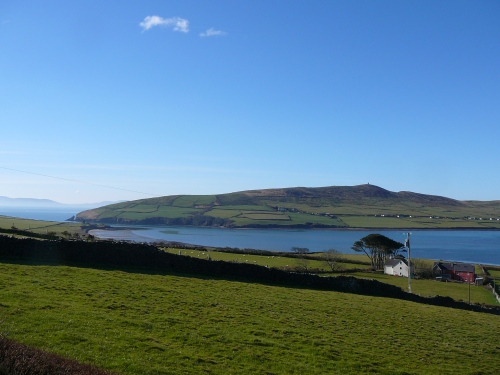
I write, now, of a day long anticipated. It’s easy to romanticize it. Maybe it’s the human thing to do: think about your heritage and romanticize it. You paint a sepia picture of the land of your ancestors, crisp and glossy and full of cultural purity. There’s a simplicity about it that cultivates a sense of innocence — a mental refuge from the modern vices of your intricate life.
I hadn’t anticipated this day would start as it had: with me sitting on the beach, next to my cousin’s girlfriend, watching him and his friends surf. But it did, and in doing so it paved the way for a journey back into time as the the day progressed.
Rónán surfs for an hour or so, and my anticipation swells with the waves. We’re soon on the road again, making our way back across the Brandon Mountains and through Dingle. We arrive at a rather large house perched high on a hill with a commanding view of the bay and the town, which looks small and flat in the distance. The house belongs to Maura and Shane O’Connor — she is Tim’s sister, making her my Grandmother’s niece, and my second cousin, once removed.

Maura looks to be in her late 60s or early 70s and is of average stature. She has soft-looking skin and a kind face that always seems like it’s about to explode with expression. She beckons us in with all the unabridged hospitality that seems to be the norm in this land. She guides us to the dining room where a quaint and bountiful lunch awaits us. She pours tea and we launch into conversation: about the family, about Dingle, about friends, and about me. Soon a new-looking, dark blue Lexus sedan rolls into the driveway. Doors open and close, and soon Shane appears in the dining room. He’s a fleshy man, with greyish white hair and a high brow. His wit is both quick and sharp, and his good humor reflects the way he is still in touch with his humble beginnings, despite the fortune he has made.
He had run a butcher shop in Dingle, and spent years living in quarters above the shop. Now he lived high above the whole town. Enraptured by the panorama, I remark that it’s a “million dollar view.” Maura smiles and tells me that my grandfather said the same thing when he first saw it.
The surrounding land is speckled with livestock here and there; mostly cattle. Rónán points to the far corner of the lot, along the main road into Dingle, where there seems to be some sort of large construction project under way.
“What’s happening down there?” he asks.
“Ah, they’re building a new hospital,” Maura replies.
“You sold some land then, did ya?” says Ró.
Maura smiles and shakes her head, and I think I catch a faint blush.
Rónán inquires further, but with grace and humility she sidesteps the question, and I get the distinct impression that the O’Connors may have donated the land for the hospital.
They’re a munificent bunch, my Irish relatives. They believe in the Father and the Son and the Holy Spirit, who proceeds from the Father and the Son and through him they act out of love for Love, and through love they expect nothing in return.
Lunch is over now, and Ró and Sarah must be going. We say our goodbyes and extend mutual offers of hospitality, vowing to stay in touch and see each other again. I met him less than 24 hours ago, but I feel like I’ve known Rónán for years. A filial bond, perhaps, or maybe just a simple compatibility of character, but I feel so immensely related to him, and I know that it’s the result of the profoundly good upbringing shared by our ancestors, passed on through the generations. They pull out of the driveway, and I feel a dull sadness at their departure, but the sun is high in the sky, and, at any rate, Shane, Maura and I must be going as well.
* * *
Speak to me. From the hills and the rocks and the jaggedly cropped mountains, speak to me. What stories can you tell? What stories of triumph, what tales of sorrow? Remind me of the laughter and the love, but tell me also of the pain and the anguish. This wild landscape, this melancholy air; how did you produce such a civilized, virtuous, warmhearted people?
* * *
The road dodges and bends with the buckled landscape. We pass through boggy lowlands, and not another car is in sight. Sheep dot the land like spilled salt, each branded with a splash of green or blue or pink or some other bright color on their backs to identify them to their owners. They pay no attention to the passing Lexus, grazing with an eternal banality. Turf fires are burning on the hills — an ancient means of rejuvenating the land, Shane explains. Illegal, but virtually impossible to police.
The road is a single lane, and in the entire hour or so that we are on it, we pull over only once or twice to allow a car coming in the opposite direction to pass. Maura explains the old Irish definition of a road: take two cows and place them adjacent to each other at a 90 degree angle; if you can fit that whole lot on whatever path you’re traveling down, then it is legally wide enough to be deemed a road. The path we’re on just barely meets this definition.
The road, paved in dark gray asphalt, winds anachronistically through the otherwise unblemished landscape. It accents the hills and irregularities of the landscape like some massive postmodern masterpiece. And above us, now, looms Corrán Tuathail the highest peak of the Mountains of East Kerry, and the highest summit in all of Ireland. Threadbare and bleak, it reigns over the landscape with all the poise and posture of an unchallenged king. The road switchbacks into the heavens, and we pass beneath the summit of The Black Stacks. Before us unfolds the the coastal plains of East Kerry.
The road leads to Killeenleagh. The road leads to provenance. The road leads to the birthplace and childhood home of my Grandmother, Noreen O’Shea McEntee. Maura narrates as we pass family landmarks: your Grandmother’s cousin worked here, your great Uncle labored here, and so on and so forth.
* * *
What is it that’s so intriguing about the birthplace and childhood home of an ancestor? What draws us to make these pilgrimages, compels us to cross oceans and traverse mountains? There’s a subtle irony in it all: they left and now we return, if only temporarily. “To find out where I came from,” one might answer, and that’s fair enough, I suppose. Certainly, it can bring clarity to our understanding of our ancestors, and that in and of itself is valuable. But is that the fundamental reason we seek out our inherited past? Perhaps. Perhaps, also, it’s a subconscious fascination with the spectrum of our mortality — not just what comes after, but what came before us. To smell the air of our ancestors and walk ponderously on their soil. To try to grasp the enormous series of events that came together to create our own lives. To find meaning in our own life through the wearisome lives of our ancestors.
* * *
Before we visit Grandma’s home, we pay a visit to Maura’s brother, Father Padraig. He’s spending the day in the house of his (and Maura’s) childhood, ostensibly clearing his mind and preparing for Holy Week. He is currently at his (and Maura’s) childhood home, in the village of Mastergeehy, a few miles down the road, past Killeenleagh. The village is a ghost town, gray and empty, seemingly abandoned for years. He greets us with the terse warmth of a deeply pensive man — quiet but disarming. He looks at me deeply, and I know he’s looking for his Aunt Noreen, and I think he knows that I’m looking for her, too.
He beckons us in, and Maura sets about preparing tea and biscuits. We sit down in a small but quaint living room. The wallpaper is light blue and garnished with a pattern of festoons. The furniture is sturdy and constructed of a dark wood — oak perhaps. The walls are adorned with old pictures and paintings and a Papal blessing for an ancestor’s marriage.

Shane O'Connor, myself, and Father Padraig Sugrue
Father Padraig leaves the room momentarily and reappears holding a stack of photographs. They’re old, but in good condition, no doubt due to the love yielded by the hands that have held them over the generations. He hands me a photograph and asks me if I can identify the person in the picture. A young girl stares back at me. She is standing in a yard, dressed in what must be her gown reserved for Sundays and special occasions. Her features are soft, her face porcelain. But her eyes: sharp and penetrating and beautiful, just as they are to this day. It’s Grandma.
We go through dozens of photos. At first, Father Padraig identifies each person for me, but after a while he goes silent and it’s understood that I’ve been introduced to the faces of just about everyone. Photograph after photograph, and I realize how precious little I know about my maternal Grandparents’ childhood. I had never seen childhood pictures of them. And why would I? They didn’t bring pictures of themselves across the Atlantic, and there just hadn’t been any pressing reason to have copies of them on hand later in life. I reckon there must be family portraits or at least photos of parents and siblings tucked away in some sacred corner of my Grandmother’s possessions, but I can’t recall ever seeing them.
In the corner of the room is a glass case filled with photographs and trinkets. Upon closer inspection, it occurs to me that they are mementos from one of my favorite stories of my grandmother’s childhood. In it are model airplanes, one clearly made of scrap metal or debris, and pictures of a similar looking plane. It appears to be a bomber, clearly marked with German insignia. During the Battle of Britain, it crashed landed in a nearby field, and my ancestors befriended the stranded German airmen. By all accounts, they were warm, friendly young men, happy to receive the hospitality of the Irish. It’s worth noting that this was years before the atrocities of the Nazis came to light, and less than two decades after Ireland won its independence from the British — centuries of tyrannical rule at their hands were very recent memories. I’m told, to that end, that the locals were happy to greet these men who were fighting the British.
It’s a prophetic trip, seeing Father Padraig, and I feel supremely prepared for the remainder of the day’s journey. We bid each other farewell, and depart. Back through the abandoned village to the main road that leads back to Killeenleagh stopping for a moment to take pictures of a tattered, dilapidated old schoolhouse — Grandma’s schoolhouse.
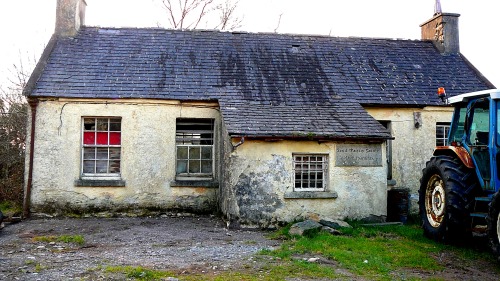
Grandma's childhood schoolhouse
The building was wretched; everything crumbling and rotting, and the whole structure seemed to slump with exhaustion. How long it had been abandoned, I couldn’t tell. It looked as if it had been made into some sort of miniature gymnasium near the end of its life, with basketball hoops up on the walls. And I wonder, now, what sort of wisdom was imparted between these walls, what knowledge had made its way from here to my own upbringing? And the Philosopher will tell you: buildings may fall, matter may lose its form, but ideas — well, those are eternal.

Inside the schoolhouse
Back up the road we go with the evening sun at our backs, dampened by a veil of clouds. The River Inny runs parallel to the road, lapping at its banks; a faithful companion. The road is empty and the ride is short. We soon pull into a gravel driveway, round a hedge, and there it is. Grandma’s home. Silent and stalwart, it stands there as it did 80 years ago. The walls are white, tarnished here and there with streaks of grime. The backyard is damp and boggy, and the masonry sheds contain small piles of turf — fuel and warmth.
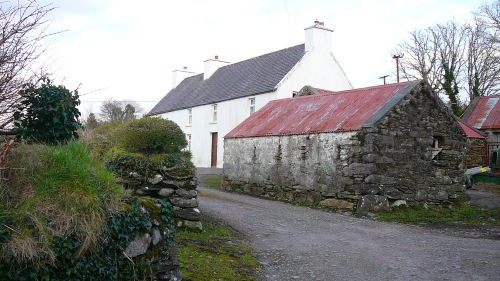
We are met by Dennis O’Shea, my Grandmother’s nephew. He is the caretaker of the property, having inherited it from his father, John. The house is currently being rented out, but the tenants aren’t home, and Dennis is happy to let us in for a peak.
* * *
Here is the place of your birth, the place of your youth, the place of your upbringing. You took your first steps here and spoke your first words there. Where did you learn to act with such dignity, with such grace, with such humility? Is that where you said your first prayer, prayed your first Rosary? There was laughter here, and I know there were tears. Times were hard and there was always work to be done. But you made it, and so did your children and so will I.
* * *
I’m told that the stove in the kitchen is original, as is the fireplace. So are the stone floors. Beyond that, the furniture and decor are mostly unoriginal. The heart of the house is clearly the kitchen. A source of warmth, and sustenance, the front door originally opened directly to it (though a wall has recently been installed to help retain warmth). The rest of the house sort of spins off of the kitchen, with a parlor off to one side, and a storage room off to the other. A narrow set of stairs takes you to the second floor, where there are a few bedrooms and a bathroom.
The house is not large. It’s certainly not small, but when one considers that a family of 15 lived here — as they did all those years ago — it is unequivocally small. And I understand now: there’s nothing truly winsome about the way of life associated with this place, nothing romantic. Of course, I’d always known that it hadn’t been glamorous, but still, it had been so easy to romanticize the good-old-days of my ancestors from afar. I had developed false nostalgia for an elegant, simple way of life in the Irish countryside. It’s so easy to do. My grandparents grew up on farms in Ireland — it rolls of the tongue and sounds so quaint and charming.
But here I am, staring the beast in the face and there’s nothing pleasant about it. It was poverty. I’d heard Grandma say it before, and now I see it. In the spartan woodwork and the stone floor, in the piles of turf and the soggy ground. Life hadn’t been easy here, and we must recognize this. When we speak of our ancestors, we must acknowledge this, and then, only then, may we come to grasp at the wisps of virtue cultivated here. That hard work brings value to life, that happiness is to be found in the small things, that religion and family ought always to come first — these are the lessons to take away.
And it is with this in mind that we leave Grandma’s home. But first we stop at the bridge over the Inny on the property, and I admire the land of my ancestors. The water reflects the waning sky in mimetic approval, and in the distance I can see the big oak tree, under the shade of which rests the remains of my great uncle John. I admire the green and the blue, the rocks and the mountains, and I give thanks: thanks to Grandma and to Grandpa and to all my ancestors, who endured and persevered and secured such a happy life for their descendants.
